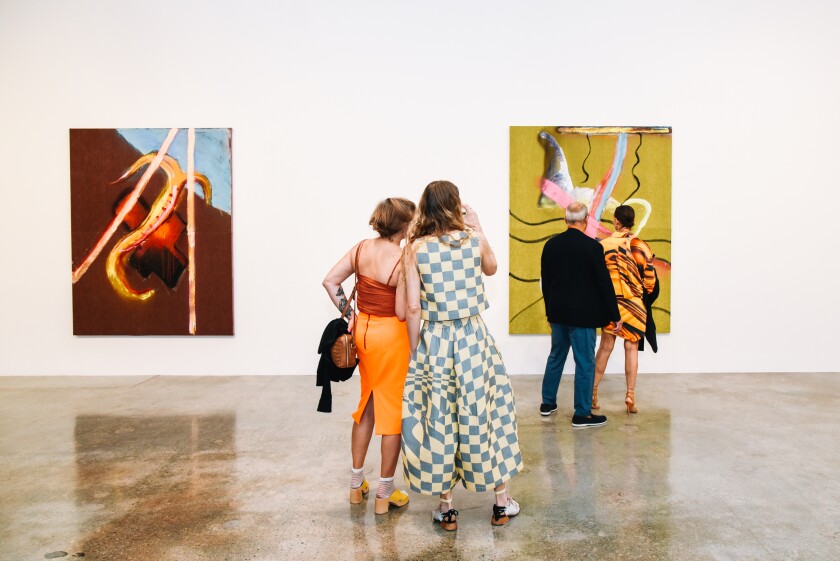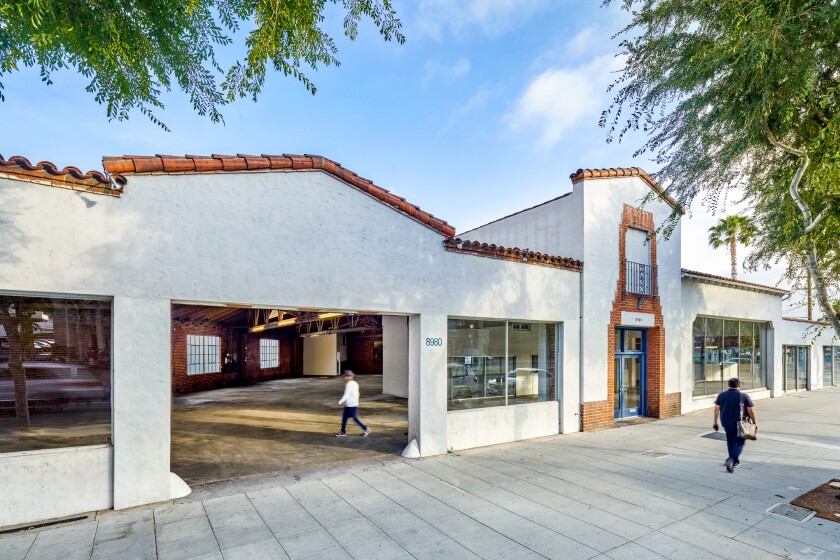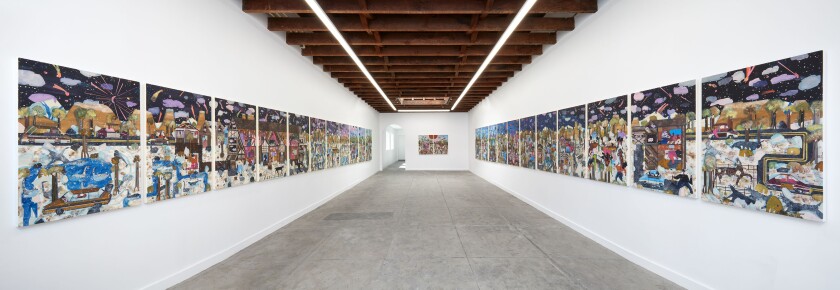Why New York art galleries are flocking to Los Angeles — and how it’s altering the art scene
Call it the great Art Rush — but panning for affluent art collectors instead of gold nuggets.
The Los Angeles gallery scene is seeing an influx of established New York art galleries moving into town as of late — 11 so far are here or coming soon. Several venues opened this February, timed to the Frieze Los Angeles art fair; other openings are in the works for later this year or 2023.
Galleries tend to coagulate around other galleries, maximizing foot traffic. And the rash of incomers has created even more robust art hubs, particularly in Hollywood and the so-called Melrose Hill area of the city. New York’s Sean Kelly gallery, Marian Goodman Gallery and Lisson Gallery will join Regen Projects, Jeffrey Deitch, Kohn Gallery and others in Hollywood — already a bustling art pocket — where New York’s the Hole opened in April.
David Zwirner gallery, along with Shrine and Sargent’s Daughters, will join Morán Morán and the nonprofit art space LAXART in Melrose Hill. LAXART plans to debut its newly purchased building there in October.
Danziger Gallery opened a space in February in Santa Monica’s Bergamot Station; Pace in Los Angeles in April joined L.A.’s David Kordansky Gallery in the Mid-City area; Karma gallery will open in West Hollywood, where Albertz Benda opened a space in April.
Got all that?

The opening of “Crush,” an exhibition of work by Adam Parker Smith, at the Hole, which opened in L.A. in April.
(The Hole and Adam Parker Smith)
Part of what’s driving the recent influx of New York galleries is circumstance — including healthy pandemic-era sales among many established galleries that are now poised for expansion, as well as L.A.’s current museum boom and its growing art collector community — but it’s also a cyclical phenomenon, says Peter Goulds, founding director of the long-standing gallery L.A. Louver, which has operated in Venice for 47 years.
“It’s a very positive thing. Any development that shifts to new generations of dealers is a good barometer of the time we’re in,” Goulds says. “But this isn’t the first time this has happened. There’s a lineage of this evolution — galleries coming from New York and even Europe — we’re just at the next crossroads.”
Reports of the L.A. gallery scene having “its moment” seem to come every 10 or so years, often from East Coast media seemingly amazed that culture thrives amid sunshine and spinning the same cliches about artists migrating west being drawn by more accessible studio space and the alluring quality of the light — and the galleries following suit. Those aren’t inaccurate dynamics, but it’s a trite oversimplification regardless. The L.A. gallery scene has been a slow-brewing and ever-evolving string of interconnected moments, says art writer Hunter Drohojowska-Philp, author of “Rebels in Paradise: The Los Angeles Art Scene and the 1960s.”
There was an L.A. gallery surge in the ’60s that got waylaid by the recession of the ’70s; a surge in the ’80s and ’90s with art galleries responding to the radical experimentation coming out of art schools such as CalArts; and the proliferation of contemporary art fairs in the early 2000s, which raised the visibility of L.A. artists, collectors and curators internationally.
“And it seems like it’s been expanding ever since,” Drohojowska-Philp says. “Sure, L.A. is the recipient, now, of a whole new group of powerful galleries from the outside, and it will undoubtedly be beneficial culturally. But it’s a plus and a minus. The local galleries, which built and sustained and supported the art scene, will have more competition. And I hate the idea of the L.A. scene being defined, in any way, by these outside forces — that has the air of colonialization.”
So why the great march west among New York galleries now, and what does it mean for the city, its artists and collectors?
Nearly every one of the seven New York gallery owners or directors interviewed for this story cited the city’s particularly robust artist community, the rapidly expanding museum scene and the growing West Coast collector base among reasons for moving into L.A.
“If you are an artist and you’re trying to reach the whole world with your art, if it isn’t being seen in L.A., it’s not gonna happen,” says Pace CEO Marc Glimcher.

Guests view work by Julian Schnabel at Pace in Los Angeles’ opening party in April.
(Linnea Stephan / BFA.com )
Glimcher has a history in L.A.: He and his father, Arne, in 1995 opened the Beverly Hills gallery PaceWildenstein, which they ran until closing in 2000. That period, Glimcher describes, felt promising for local galleries — Blum & Poe opened its doors in ’94, for one thing. But the current gallery expansion feels less burgeoning and more “essential,” Glimcher says, explaining why Pace, which recently announced it will be closing its Palo Alto location, has returned to L.A. 22 years later.
“Los Angeles has some of the most important artists in the world working here,” he says. “It has the most important thinkers, curators, museum people and collectors. And we’re seeing a significant rise in the number of collectors in L.A. or who spend time here — the tech community has moved a lot of its time and space here. Just look at who owns the homes in Malibu now versus five years ago.”
For Sean Kelly, it might be a case of FOMM — Fear of Missing Money. Kelly says that his son, Thomas Kelly, a partner and director of the gallery, made a case for moving to L.A. about two years ago. “He came to us and laid out a program and said, ‘Look, these are our artists who are not represented in L.A. There is interest in them from other galleries. If we don’t do this, somebody else will take these artists.’”
Kelly says he sees the move into L.A. as a “two-way cross-fertilization.”
“Yeah, we’re gonna come to L.A.,” he says. “But we also want to make sure there’s plenty of space for us to respond to L.A. and bring part of L.A. to New York as well.”
“The last time I’ve seen a migration like this was Miami in the early 2000s shortly after Art Basel opened up [there],” says Thea Smolinski, an art advisor and private collections manager based in Eagle Rock. “The biggest difference, though, is how sustainable it feels right now. L.A. collectors are really invested in L.A. artists and galleries. A lot of my clients do their primary buying in L.A. Space is getting harder, but it’s an exciting time to be an artist in L.A.”
Or is it?
Artist Greg Ito, who operates the family-owned gallery and project space Sow & Tailor downtown says the growth is a “double-edged sword” for artists. More galleries means more opportunities for exhibitions and sales. But to what end?
“A lot of these bigger galleries, they’re opening multiple spaces globally but also locally, so they go from having to schedule 10 shows a year to 20, 30, 40 shows a year, and they’re just churning out artists. The market is hot and everyone is buying everything, but it turns an artist’s work from intimate and critical into what feels like trading cards. The question is: Are they moving to L.A. to contribute to the cultural landscape here or to take from it?”
“Just being New York-centric is not enough anymore.”
— Marian Goodman Gallery President and partner Philipp Kaiser
David Zwirner says a “dramatically” increased collector base not just in L.A. but throughout California played a role in his gallery’s move west — as did collectors in China, Hong Kong and Korea who prefer to meet in L.A. “But the most important reason is: This is such a vibrant artist community, and artists really want to have their work exhibited in L.A.,” he says. “That’s really what pushed me over the edge.”
The L.A. collector base may be growing, says Christopher Ford, a longtime L.A. gallery director at different outposts from the mid-’80s until 2017, but it’s changing — and not for the better, in his view.
“They’re not collecting for the same reasons,” Ford says. “A handful of collectors built MOCA; they cared about art and Los Angeles. Now, the art world has become a casino. They’re often selling to people they know are probably going to flip it — it’s five-card monte on a cardboard box on a street corner.”
The gallery expansion is flowing in two directions, points out longtime art collector Beth Rudin DeWoody, with L.A.’s David Kordansky Gallery, Nino Mier Gallery and François Ghebaly opening additional spaces in New York.
“Dealers are looking for a wider audience for their artists,” Rudin DeWoody says. “The art world is bicoastal now and international with the art fairs. Most collectors don’t limit themselves to their local galleries.”

A rendering of Hauser & Wirth’s West Hollywood site, which plans to open its doors this fall.
(Elon Schoenholz Photography © 2021; Hauser & Wirth)
To what extent the gallery growth is sustainable remains to be seen. The New York galleries join an already-ballooning L.A. gallery scene. Several local galleries have recently opened larger or second spaces in the city or have plans for expansion. Hauser & Wirth will debut a second space in West Hollywood this fall; Night Gallery, downtown, expanded into a nearby space in January, doubling its square footage; Gaga & Reena Spaulings Los Angeles opened a larger Hollywood space in February; Nino Mier Gallery opened a new space in Glassell Park that month as well; and De Boer Gallery expanded its Boyle Heights space in early 2021, tripling its footprint.
Even smaller spaces are growing: Smart Objects, in Echo Park, expanded into an adjacent storefront, tripling its square footage. La Loma Projects, an artist-run space operating out of owner Kirk Nelson’s Pasadena home, opened a storefront in Highland Park last year.

Work by Andrea Joyce Heimer, on view this spring, at Nino Mier Gallery’s new Glassell Park space.
(Paul Salveson)
But at a certain point, won’t the bottom drop out?
Not necessarily, says Sophie Perceval, co-founder of the Toronto-based research lab Wondeur AI. The market growth indicates local demand among collectors, she says, which then reinforces the attractiveness of the L.A. art scene for them. According to a 2022 UBS report on top U.S. art cities, which Wondeur AI contributed to, collectors view L.A. as a place to acquire work by top-tier, established artists more so than emerging artists.
“So what could be the impact of all these mega galleries expanding into L.A.?” Perceval says. “It’s going to reinforce the top end of the commercial gallery ecosystem, meaning the galleries showing more successful and established artists. It’s already a trend there.”
That doesn’t necessarily mean that the small to midsize galleries will suffer fewer sales, she says. “L.A. has such a high concentration of galleries, according to the report, that’s an indication there is business to support them.”
But doesn’t rising inflation and a possible recession later this year or next mean the art market will likely contract, as it did in 2008 and 2009?
“We couldn’t rule it out, but [the Great Recession of 2008] was a once-in-a-lifetime downturn,” says Adam Fowler, a founding partner at CVL Economics, which authors the annual Otis College Report on the Creative Economy analyzing California’s creative industries. “There are certain luxury goods in an economy that aren’t impacted as much during softer downturns. And you can have downturns that are siloed in their impact.”
Technology, particularly social media, has made art more accessible and mainstream, Fowler adds. And that’s created a sort of democratization in the art world that’s leveled the playing field for L.A.
“There’s decentralization across the major gallery hubs,” Fowler says. “Consumers live all over the globe, and not all of them are gonna go to those gallery rows in New York and London anymore. And Los Angeles, in terms of demographics, is a little younger and has connections to the markets, especially of Asia and Latin America, that maybe New York doesn’t have in the same way.”
Ironically, the pandemic, which shuttered so many businesses, he says, has accelerated the recent gallery scene growth. “We’ve had two-plus years of pandemic that’s backlogged a lot of business and personal decisions,” he says. “Any time you put the brakes on markets, there’s often a glut of activity waiting to spill out.”
For Scott Ogden, owner of Shrine, which will share a divided L.A. storefront with Sargent’s Daughters, the pandemic led to the need for expansion.
“When we were forced to close, I thought it would be the end of everything,” Ogden says. “We quickly decided to do online shows, and I introduced e-commerce. We actually grew the last two years. More transactions. New contemporary artists came on. Still, there’s something special about seeing art in person. Now I find that if I meet a new artist, without L.A., the first physical show I can offer them is eight to 12 months away. L.A. felt like an interesting place to [expand].”

Danziger Gallery, at Santa Monica’s Bergamot Station, during its inaugural opening in February.
(Danziger Gallery)
The art gallery and museum scenes may seem diametrically opposed in terms of missions — the former intent on selling, the latter focused on exhibiting and educating — but they’re “symbiotic,” says Pete Scantland, an art collector who serves on the board of L.A.’s Museum of Contemporary Art. “Museums rely on galleries to promote the careers of artists. It’s an ecosystem: Galleries provide commercial opportunities for artists to build a career. And the museums provide another essential role, which is showing and collecting the work of artists and preserving it for the public, contextualizing and interpreting the art.”
A robust gallery scene is “inevitably good” for all of the city’s nonprofits, not just museums, says Scott Stover, a leading philanthropy advisor specializing in arts and culture.
“When you have a more vibrant market presence, it should result in greater contributions to local nonprofits,” Stover says. “It’s not immediately obvious. But it can only be a benefit. Having more major galleries present will help facilitate art donations.”
Marian Goodman Gallery President and partner Philipp Kaiser, formerly a senior curator at MOCA, says deepening relationships with L.A. institutions was a primary draw of coming to L.A. “Art is a global business, but we want to give a physical presence to our artists in one of the most vibrant creative cities where there’s a lot of attention from curators and collectors,” he says. “Just being New York-centric is not enough anymore.”
If the art world is global and has no boundaries, with galleries relying on virtual programming as well as art fairs and digital outreach for sales, then why open a physical storefront — or several — at all? Are bricks-and-mortar spaces just local, promotion-generating vehicles?
“The direct in-person experience, even with digital art, is not replaceable,” says gallerist Jeffrey Deitch. “But also: You want to be on the ground, cultivate patrons, be in it for the long run and give art to the museums, make a genuine contribution to the community.”
The art market may be nothing if not a guessing game, but one thing is certain: Parking in Deitch’s Hollywood neighborhood is going to get even harder.
Which raises the question: Is there room for everyone in L.A.?
“I’m delighted to welcome them,” says Deitch. “This will energize the local scene and draw even more people from around the U.S. and the world. It will be an important multiplier for the entire L.A. economy — and you’ll see it resonate in the culture.”
Gallery Weekend Los Angeles
Gallery Assn. Los Angeles will hold its second annual Gallery Weekend Los Angeles starting on Wednesday, with four days of coordinated openings among more than 70 local galleries and art spaces spotlighting a different neighborhood each day.
Wednesday: Westside
Thursday: Hollywood, West Hollywood
Friday: Mid-City and South L.A.
Saturday: Downtown and Eastside
Info: galleryplatform.la/info
For all the latest Entertainment News Click Here
For the latest news and updates, follow us on Google News.
